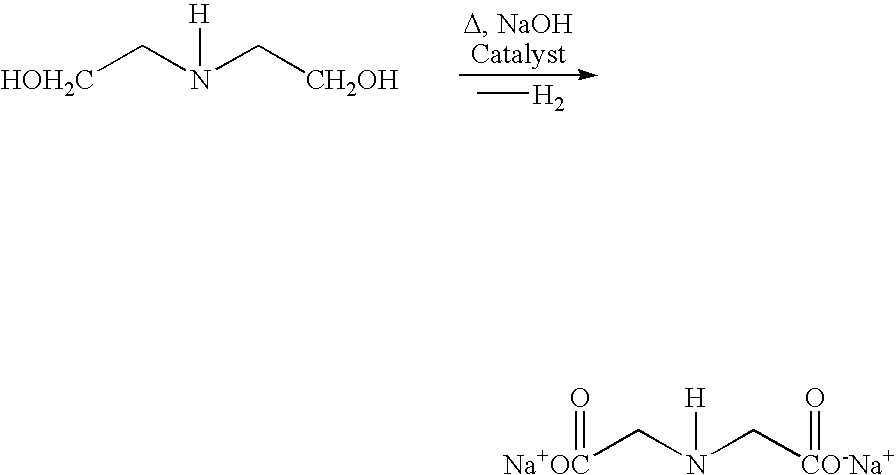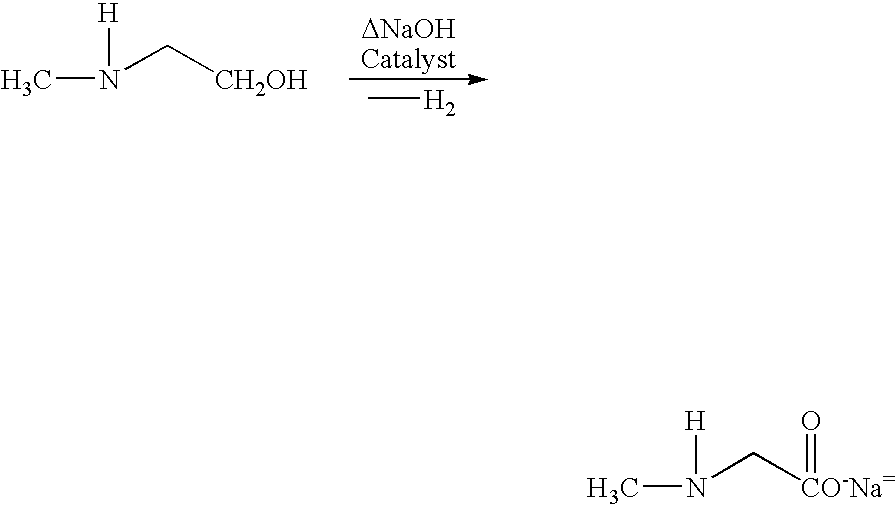Process and catalyst for dehydrogenating primary alcohols to make carboxylic acid salts
a carboxylic acid salt and primary alcohol technology, applied in the field of new products, can solve the problems of short duration of maximum catalytic activity of copper-containing compounds, inability to deactivate copper, disadvantages of raney copper, etc., and achieve the effect of increasing the selectivity of the desired carboxylic salt product, reducing undesirable side reactions, and high surface area
- Summary
- Abstract
- Description
- Claims
- Application Information
AI Technical Summary
Benefits of technology
Problems solved by technology
Method used
Image
Examples
examples 1 , 3 , 5
Examples 1, 3, 5, and 7 illustrate electrochemical displacement deposition of copper onto a metal sponge support. The same examples also illustrate the use of a chelating agent during such a deposition.
In a particularly preferred method for the deposition of copper onto a metal support, electrochemical displacement deposition is conducted under basic conditions followed by electrochemical displacement deposition under acidic conditions. Preferably, the metal support is free of surface oxidation at the time of the plating. However, in instances where the metal support has an oxidized surface (i.e., when the support has been exposed to air (even while under water) for 6 or more months), it is particularly preferable to pre-treat the support with a reducing agent. For example, the support may be stirred in a sodium borohydride solution, which preferably comprises a solution having a pH of at least about 10 and at least about 1 gram of sodium borohydride per 25 grams of metal support. ...
examples 9 , 11 , 13 and 23
Examples 9, 11, 13 and 23 illustrate the use of electroless plating to deposit copper onto the surface of a metal support.
iii. Use of an Iron Catalyst Modifier
As described above, it is sometimes preferable to use iron as a catalyst modifier when using a copper / nickel catalyst within the process of the present invention. For example, it has been found that iron as a catalyst modifier is useful to reduce the activity of exposed nickel in the reaction mixture for catalyzing one carbon elimination reactions, or in the case of dehydrogenating diethanolamine, to reduce the activity of exposed nickel for catalyzing the formation of byproducts. By reducing the activity of nickel for catalyzing such unwanted side reactions within the process of the present invention, the presence of an iron catalyst modifier can increase selectivity for the desired carboxylic acid salt.
The amount of iron to be used as a catalyst modifier can vary within wide limits; and, experience to date does not sugg...
examples 28
demonstrates the deposition of iron as a catalyst modifier after the electrochemical displacement deposition of copper onto a nickel sponge support and Example 29 demonstrates the use of an iron modified catalyst in the dehydrogenation of diethanolamine.
2. Other Copper-Containing Catalysts
In another embodiment of this invention, the catalyst does not comprise copper coated on a metal support (i.e., there is no discrete copper deposited on or coating the surface of the catalyst). Rather, the copper is mixed (preferably in the form of an alloy) with other metals which provide desirable properties to provide a catalyst active phase. In this embodiment, from about 10% to about 85% (more preferably from about 50% to about 85%, even more preferably from about 60% to about 80%, and still more preferably from about 60% to about 75%) by weight of the catalyst is copper. Preferably, the catalyst is in the form of a metal sponge. In a particularly preferred embodiment, the catalyst comprise...
PUM
| Property | Measurement | Unit |
|---|---|---|
| yield strength | aaaaa | aaaaa |
| reaction time | aaaaa | aaaaa |
| reaction time | aaaaa | aaaaa |
Abstract
Description
Claims
Application Information
 Login to View More
Login to View More - R&D
- Intellectual Property
- Life Sciences
- Materials
- Tech Scout
- Unparalleled Data Quality
- Higher Quality Content
- 60% Fewer Hallucinations
Browse by: Latest US Patents, China's latest patents, Technical Efficacy Thesaurus, Application Domain, Technology Topic, Popular Technical Reports.
© 2025 PatSnap. All rights reserved.Legal|Privacy policy|Modern Slavery Act Transparency Statement|Sitemap|About US| Contact US: help@patsnap.com



